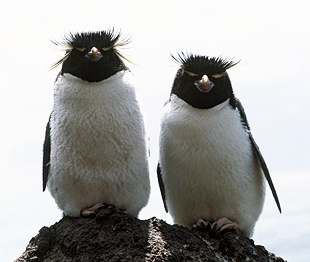Related articles on endangered birds
|
|
|
Above top: Grey duck. Photo R. Sutton, Crown Copyright © Department of Conservation
 See more on grey duck See more on grey duck
Above 2nd down: Eastern rockhopper penguin. J.L Kendrick, Crown Copyright © Department of Conservation
 See more on penguin See more on penguin
Above 3rd down: Grey-headed mollymawk. Photo: Christo Baars, © Australian Antarctic Division 2008 Kingston Tasmania 7050
Above bottom: New Zealand storm-petrel. Copyright © 2005 Brent Stephenson
www.eco-vista.com
 View larger image View larger image |
|
|
 |
| |
Three more native birds listed as critically endangered |
| |
17 April 2009
The status of three native birds has worsened, joining New Zealand's 22 most endangered birds listed in the 2008 New Zealand Threat Classification System.
The new listing for grey duck Anas superciliosa superciliosa (top left) has worsened from 'nationally endangered' to 'nationally critical'. The grey duck population is diminishing because of hybridisation with non-indigenous mallard duck Anas platyrhynchos platyrhynchos.
The status of the Eastern rockhopper penguin Eudyptes chrysocome filholi (left 2nd down) has moved one step up from 'nationally endangered' to 'nationally critical'.
The grey-headed mollymawk Thalassarche chrysostoma (left 3rd down), jumped from 'serious decline' in 2005, to 'nationally endangered', and now 'nationally critical'.
It is found on Campbell Island in New Zealand's subantarctic ocean, and another seven island locations in the Southern Ocean.
The grey-headed mollymawk is the only species listed as 'nationally critical', of the eleven albatross or mollymawk (Diomedeidae) species that breed in New Zealand. It is 'vulnerable' on the 2008 IUCN Red List of Threatened Species.
The IUCN Red List lists four 'critically endangered' Diomedeidae birds, including the Chatham Island mollymawk Thalassarche eremita.
The New Zealand storm-petrel Oceanites maorianis (left bottom) is currently listed in the 'data deficient' category. It was miraculously rediscovered in 2003 off the Coromandel Peninsula, after only being known from three museum specimens collected more than 150 years ago.
The New Zealand storm-petrel is listed as 'critically endangered' on the IUCN Red List of Threatened Species.
There have also been New Zealand storm-petrel sightings off Little Barrier Island in the Hauraki Gulf, and three birds were banded and fitted with transmitters in 2006 near the Hen and Chickens Islands, but their breeding location has not yet been found. |
| |
 |
| |
References:
Miskelly, C.M.; Dowding, J.E.; Elliot, G.P.; Hitchmough, R.A.; Powlesland, R.G.; Robertson, H.A.; Sagar, P.M.; Scofield, R.P.; Taylor, G.A.; Conservation status of New Zealand birds, 2008. Notornis Vol. 55: 117-135, 2008.
Rhymer, J.M.; Williams, M.J.; Kingsford, R.; Implications of phylogeography and population genetics for subspecies taxonomy of grey (Pacific black) duck (Anas superciliosa) and its conservation in New Zealand. Pacific Conservation Biology10: 57-66, 2004.
Williams, M.; Basse, B.; Indigenous gray ducks, Anas superciliosa, and introduced mallards, A. platyrrhynchos, in New Zealand: Processes and outcomes of a deliberate encounter. Acta Zoologica Sinica 52 (supplement): 579-582, 2006. |
| |
 |
| |
|
|

A pair of critically endangered Eastern rockhopper penguin Eudyptes chrysocome filholi.
J.L. Kendrick, Crown Copyright © 1968 Department of Conservation
|
|
Grey duck, eastern rockhopper penguin and grey-headed mollymawk, all of which have large populations, are believed to have declined or be declining at more than 70 percent per 3 generations [Miskelly et al. 2008].
Without immediate and innovative management, probably on the Chatham Islands, pure-bred grey ducks are likely to be extinct in the New Zealand region within a decade [Rhymer et al. 2004; Williams & Basse 2006].
The eastern rockhopper penguin Eudyptes chrysocome filholi is a subspecies of the Southern rockhopper penguin Eudyptes chrysocome which is one of seven species of crested penguin in the world.
Four crested penguins only breed in New Zealand. The eastern rockhopper is the smallest at 40 cm tall and with an average weight of 3.35kg.
The New Zealand subspecies breeds on Antipodes, Auckland and Campbell Islands. As its name suggests, it is adept at moving around rocky coastline, and like the erect-crested penguin climbs steep cliffs.
Over four decades from the 1940s to the 1980s, the rockhopper population on Campbell Island decreased by about 94 percent. The reason is not known, but an increase in sea-surface temperatures may be the cause. In 1985, there were an estimated 51,500 birds.
There have been declines on all three subantarctic islands, and probably only 200,000 birds remain.
Declines have been reported throughout most of the eastern rockhopper penguin's circumpolar subantarctic range, which include Marion, Prince Edward, Crozet, Kerguelan, Heard, and Macquarie Islands.
Rockhoppers sometimes nest alongside erect-crested penguins on Antipodes Island, a co-habitation trend that also occurs between the Antipodes Island parakeet and Reischek's parakeet. |
| |
 |
| |
 |
| |
|



